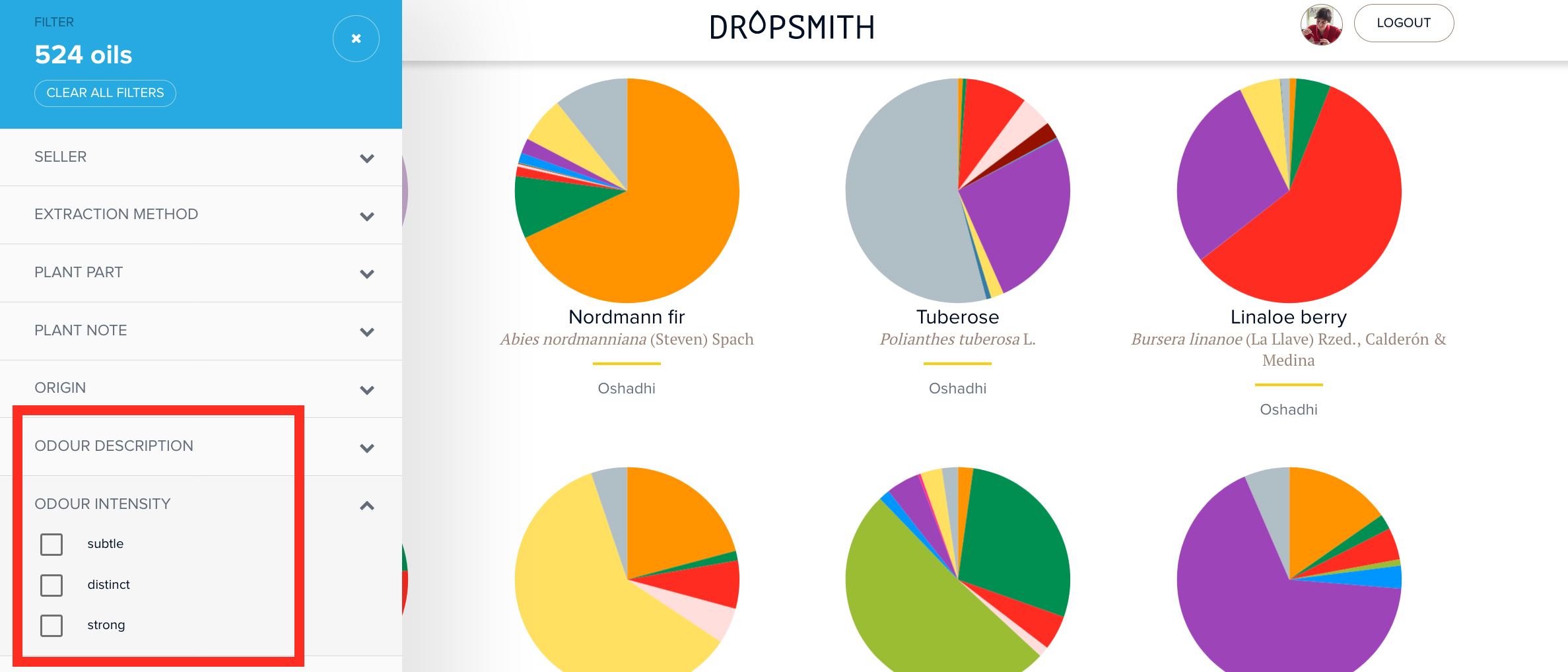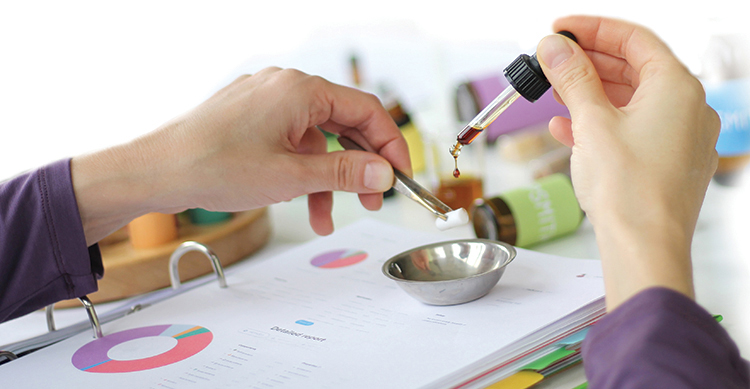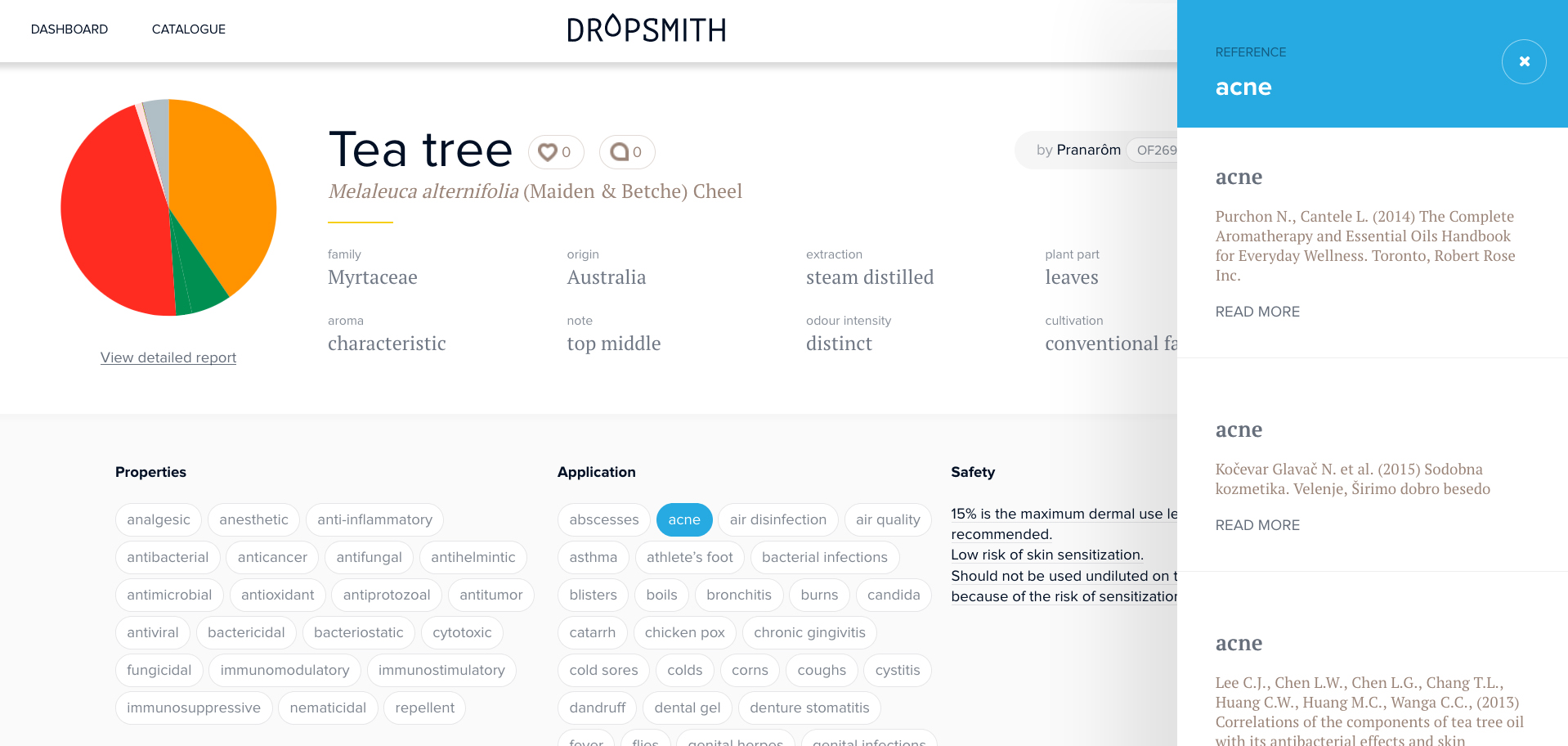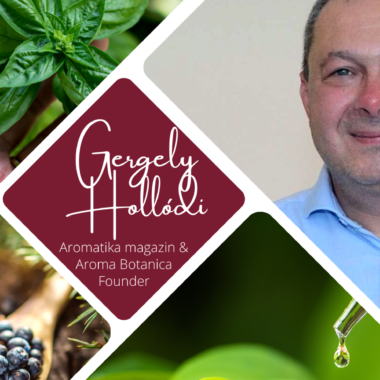When blending for therapies we often concentrate more on the therapeutic result rather than the aroma of the blend. Nevertheless, it is always valuable to keep in mind the fragrance especially when blending for skin care products. After all, a lot of clients are drawn to aroma-cosmetics because of its pleasant aroma and don’t forget that in Dropsmith you can filter essential oils by odour description as well as odour intensity 🙂

Describing smell
Filter essential oils by odour description such as floral or spicey, you can filter by more words than one and see if you agree. Do remember that smell can be subjective and essential oils from different distillers may smell different too.
In the early 1970s, Paolo Rovesti had noted that individuals appeared to respond better to essential oil combinations rather than a single oil. Nobody responds positively to an odor that they dislike. Odors of some undiluted essential oils can be very strong and perceived as unpleasant. Consequentially, the smell of the mixture could be perceived as being more agreeable.
Rovesti’s observation has further underpinned the aromatherapy practice of prescribing essential oil blends, rather than single aromatics. Understanding the concept of synergy is of great value for anyone who attempts to blend oils to genuinely understand which essential oils to combine and why. Sometimes, essential oils, as well as their components, may, in fact, have opposing properties, and the overall effect of the oil will depend on the relative proportions of antagonistic components.
Luckily, we have Dropsmith to help you along and not only warn you about these important properties but calculate them for you as well. This will distinguish your work and bring value to it all while saving you precious time searching and comparing articles. 🙂

Tips for maximizing synergy potential when blending
1. Have a clear purpose and focus for your blend
The most common mistake when blending is to try to achieve too many goals with one formulation. This is always very tempting, as one essential oil covers such a vast variety of issues. Still, try and contain yourself because this way you are probably diluting the blend by getting sidetracked and making your first goal less effective. Also, having a clear aim will help you follow up on your progress.
Avoid oils that clash with your goals. For example, although Rosemary CT verbenone essential oil is wonderful for damaged and sensitive skin, but you would probably want to avoid it in preparations used right before sleep because it is also very energizing.
When you start selecting oils for your blend use the synergy design and Dropsmith will help you along to make effective synergies.
2. Select essential oils that complement one another: therapeutically, chemically, energetically, and/or aromatically
Let’s take a look at the three most common approaches to blending in a professional setting.
- Chemistry blending
In this approach, you choose your essential oil by looking at its chemistry. You can start by looking at the general groups (alcohols, ketones, phenols, etc.) or looking deeper by components (linalool, geraniol, 1,8-cineole, etc). For example, an essential oil rich in linalool will create an excellent anti-inflammatory product such as acne or aftersun cream, it may also be helpful with skin problems such as rosacea. To support this synergy you may blend Lavandin, Neroli, Rosewood, Ho wood or perhaps something more exotic such as the lovely Magnolia flower or leaf, Coriander seed and unusual Linaloe berry. - Therapeutic blending
You may feel more comfortable choosing your essential oils based upon therapeutic properties. For example, you might select Lavender for its antioxidant properties, Vetiver for its unique smell and fixative action or Blue chamomile for wound care, etc. Perhaps you’ll decide to enhance the antifungal effect of Patchouli by combining it with another antifungal essential oil such as Palmarosa for a foot gel. - Blending by smell
When pleasure or intuition is your final goal, such as is the case with making a lovely natural perfume, you may want to approach blending by the smell. Choosing all three notes, taking care of the intensity and the bouquet of your final blend.
Are you ready for the Next Level?
I dare you to do my – fun assignment :
exploring smell through chemistry.

Use Dropsmith to search by odour.
- Which oils have the strong odour?
- Have you noticed similarities between oils with high notes?
- Which chemical groups tend to be dominant in oils that have a flower-like smell?
Drop your comment below and let me know what you discovered 🙂 I am curious.
3. Double check the safety recommendations
It is your responsibility to select essential oils that do not have safety issues that can affect other aspects of clients health. Pay extra attention to the vulnerable categories such as:
- age (elderly, children),
- skin integrity and skin health,
- compromising health problems such as liver and kidney disease.
4. Sometimes less is more and sometimes less is just that – less
Use up to seven different essential oils in a formulation to avoid diluting and losing focus. Using a given essential oil below cosmetically active levels can make your blend less active or not active at all. Dropsmith references can help you out here, by clicking the ‘READ MORE’ and checking out the article or book to find out the additional information on the subject.

- The core essential oil should express the primary purpose of the blend.
- Additional essential oils are the enhancers or the harmonizers.
- The enhancer essential oil(s) strengthen the core essential oils in aim.
- And the harmonizing essential oil(s) supports and enhances the overall synergy.
6. The professional approach
When blending from a professional framework make sure to focus on either chemical groups or components, moreover, ensure essential oils complement the final goal.
7. Choosing the base
Your base is an important part of your formulation. Essential oils are very rarely used undiluted on the skin and strictly for clinical purposes. Your base should complement the nurturing goals of your essential oils synergy. The base or the carrier we placed our essential oils in, may, sometimes, be just as important as the essential oils themselves.
- The carrier can include:
- gels,
- emulsions (lotions or creams),
- vegetable butters or oils,
- and other bases as well.
The idea is to create a complementary and cosmetically active base, to enhance the overall cosmetic activity of the blend.
7. Choosing the right amount
Content is important! Acute skin conditions such as sun burn tend to require higher dosages than chronic skin conditions, as well as emotional conditions. Different writers and practitioners hold various views on dosage and application.
Tisserand and Young (2014) suggest the following:
- for massage purposes, when large areas of skin are covered, it is generally recommended to use a concentration of 2.5 to 3.0%, and 5.0% should be the maximum,
- for the young and elderly, 1.0 to 2.0% is recommended,
- for relaxation purposes or more regular use, 2.0 to 2.5% is sufficient
- for facial use, 0.5% is the maximum recommended.
Read more on Tisserand’s safety guidelines here.
It is also possible, in some cases, that very small doses are just as effective as larger doses.
Essential oils are most commonly dispensed in drops. However, drops vary in volume depending on the viscosity, specific gravity and the dimensions of the dropper insert. The volume of a drop of essential oil is very approximately 0.05 ml. It would be better and much more accurate to prepare blends by weight, using laboratory balance, or by volume with pipettes and calibrated glassware. However, in the therapeutic environment drops are appropriate and fit for purpose. The assumption, that there are 30 drops per 1 ml, has proved to be a useful tool for home blending.
Number of essential oil drops = (% of blend) x (ml of carrier oil) / 5
Now, circling back to the beginning of the lesson, do you remember when we discussed that we always search for limiting or critical compounds that represent the greatest risk to use within the essential oils we use? Well, limits may be due to several reasons:
- Phototoxic activity, especially furanocoumarins from oils such as bergamot and other cold pressed citrus essential oils.
- Possible cause of allergic reactions or sensitizing effects. There are widely used compounds such as aldehydes neral and geranial, and geraniol and citronellol which are found in essential oils such as Lemongrass, Melissa, Palmarosa, Geranium and Rose or more exotic oils like Lemon myrtle or May chang – you can look up all of these oils as well as filter oils by components by logging in in Dropsmith 🙂 Some compounds like linalool and geraniol and citronellol alcohols are not very sensitizing, but their oxidation products that are formed through time are. Interesting fact, linalool makes up for over 95% of Rosewood and Ho wood essential oils and is found at over 20% in many essential oils commonly used in cosmetic products – check it out here. There are, of course, other examples as well. Phenols and aromatic aldehydes tend to have very low limits and therefore the essential oils that contain these compounds must be used at very low concentrations such as Cinnamon bark and leaf, Clove, Cassia, Oregano, phenolic thyme chemotypes, etc. Now go, and check it out for your self!
- Possible carcinogenic effect. Safrol is one of them, but oils rich in safrole are not used in cosmetic products and aromatherapy anyway. Methyl eugenol is the compound that causes most controversies, as it is found in various oils used in aromatherapy.
Thank you, Marija! The beginning of this blog was generously shared by my dear friend and colleague Marija Karlović*. You can read more about her at the bottom of the blog post.
Dropsmith to the rescue 🙂
If all of this information seems overwhelming, please remember you may always lean back on Dropsmith. I’ve created it with you in mind and wanted to make safe and efficient blending with essential oils available and easier for everyone. Safety is quite often the fundamental reason for choosing an oil. Do take advantage of this opportunity to get to know the full benefits of almost 800 essential oils. Now go ahead – have fun, discover new oils and be creative! 🙂
* Marija Kolarović, Mr. Ph.
Pharmacist, Clinical Aromatherapist, Phytotherapist and educator
With almost 20 years of experience working with patients in a clinical setting, Marija has taken her passion for nature and phytotherapy to the next level by providing quality aromatherapy remedies for her patients at the apothecary as well as sharing her knowledge through aromatherapy education. Her formulations include a vast variety of aroma cosmetics, as well as suppositories and vaginalettes (with which she has great success treating patients with HPV infections). She’s founded a non-profit organization Verbena through which she organizes and provides aromatherapy and natural cosmetics education. She believes education is the key to unlock the mystery of formulating.






